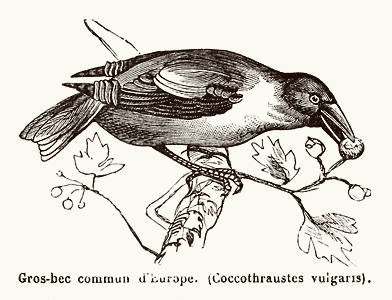Grosbeak

GROSBEAK. s. Ornith. Genus of conirostres passerine birds, which still has to be clearly defined and includes a great number of species with a short, right, conical, very large and pointed bill. In the linnaean classification, the grosbeak or hawfinch belongs to the broad fringilla genus. These birds are to be found all over the known world. The common European grosbeak (coccothraustes vulgaris, Briss.), widespread in all Europe, is rather rare in France. It is approximately 16 cm (6.3 inches) long, and has a wingspread of 25 cm (9.84 inches). It feeds on seeds of various trees (hornbeam, plane tree, pine), on cherries, on hawthorn seeds, on laurel berries and, in the summer, on what is available in gardens, particularly green peas and buds. Its call is pleasant, but plaintive. It can live in couples in our wooded mountains or it can be solitary; in the winter, it flies down to the plains. The female lays from three to five eggs of an ashen white colour, mottled with blue and brown; it is one of most beautiful birds that we have. Its head, neck and back are of various shades of brown; its tail and the lower part of its neck are greyish; it has black spots on the head and throat; reddish spots on the rest of the body.
– We can also find the Green Grosbeak (coccothraustes chloris), which is common in our thickets. It is greenish on the back, yellowish on the belly. Its bill is not as big as that of the hawfinch. It feeds on any kind of seed, and can live in captivity.
– Other species of fringillas are still called grosbeaks. Such is the case with the pine grosbeak (pinicola canadensis, Cab.), 17 cm long, One of the most beautiful American species. It lives Arctic America, Canada and the north of the United States, up to Pennsylvania. It is a charming singer, and is easy to domesticate. The evening grosbeak (hesperiphona vespertina, Bonap.) is to be found in the N – O. of the United States. (See Cardinal)
Extract from the Trousset encyclopedia, 1886 – 1891.
Tags: animals, birds, fringilla, hawfinch, ornithology, Trousset encyclopedia


